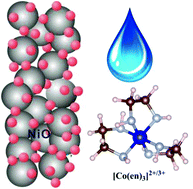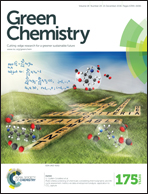Aqueous p-type dye-sensitized solar cells based on a tris(1,2-diaminoethane)cobalt(ii)/(iii) redox mediator†
Abstract
For the first time, we report the assembly of p-type dye-sensitized solar cells (pDSCs) based on an aqueous electrolyte containing a tris(1,2-diaminoethane)cobalt(II/III) ([Co(en)3]2+/3+) redox couple. With exception of devices made with pH 8.15 electrolytes (η = 1.13%) constant energy conversion efficiencies close to 1.5% were achieved with all other electrolytes under simulated one sun illumination (AM 1.5 G), with the best cell achieving an efficiency of 1.6%. Even higher efficiencies (≥1.9%) were achieved at a lower light intensity indicating that mass transport may be limiting performance at higher light intensities. The drop in VOC with increasing pH is compensated by improvements in the short circuit current and fill factor. Notably, the efficiencies reported here for electrolytes with pH > 9 are higher than those reported for the corresponding devices made with an organic electrolyte based on the same redox mediator.


 Please wait while we load your content...
Please wait while we load your content...